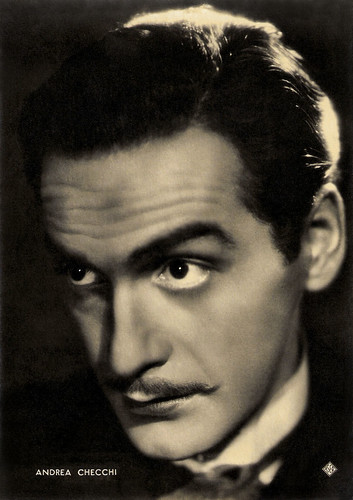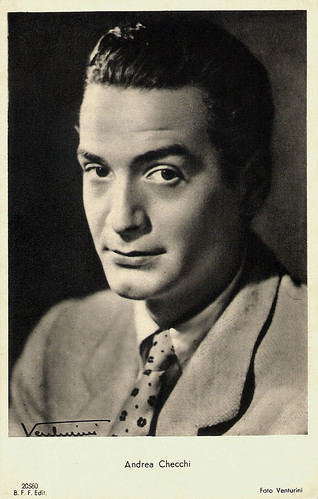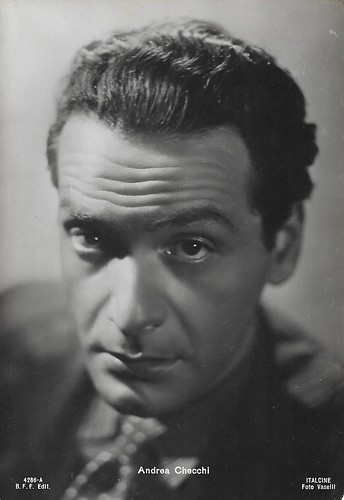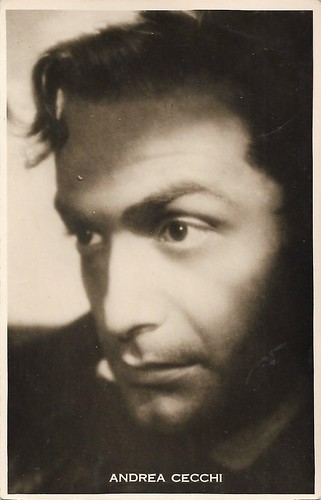Andrea Checchi (1916-1974) was a prolific Italian film and television actor, who peaked as a leading actor in the early 1940s. He had important supporting parts in post-war Neorealism and beyond.

Italian postcard by B.F.F. Edit (Casa Editrice Ballerini & Fratini Firenze), no. 4359 A. Photo: Lux Film / Foto Vaselli. Publicity still for Malombra (Mario Soldati, 1942), in which Checchi played Corrado Silla, opposite Isa Miranda as Marina di Malombra.

Italian postcard by ASER (A. Scararamaglia Edizioni Roma).

Italian postcard by ASER, no. 201.

Italian postcard by Casa Editrice Ballerini & Fratini, Firenze (B.F.F. Edit.), no. 4347. Lux Film. Photo: Vaselli. Made for the period piece Malombra (Mario Soldati, 1942), an adaptation of the classical novel by Antonio Fogazzaro.
Andrea Checchi was born in Florence in 1916. He was the son of painter Amedeo Checchi. At a very young age, he moved to Rome, where he frequented the film academy Centro Sperimentale di Cinematografia.
At age 18, he debuted in the historical film 1860 (Alessandro Blasetti, 1934), and less than one year after he had a secondary role in Blasetti’s Vecchia guardia/Old Guard (Alessandro Blasetti, 1934).
Many secondary parts in film followed until he had his breakthrough in the war propaganda film L'assedio dell'Alcazar/Alcazar (Augusto Genina, 1940) starring Fosco Giachetti, and even more in the comedy Ore 9 lezione di chimica/Schoolgirl Diary (Mario Mattòli, 1941), in which he had the male lead opposite Alida Valli, Irasema Dilian and Bianca Della Corte.
Then came the realist romantic comedy Avanti c'è posto/Before the Postman (Mario Bonnard, 1941), in which he rivalled with Aldo Fabrizi for the hand of the young Adriana Benetti. The film was written by the young Federico Fellini.
Other memorable parts were his leads in Via delle cinque lune/Street of the Five Moons (Luigi Chiarini, 1942), Malombra (Mario Soldati, 1942) starring Isa Miranda, and La contessa Castiglioni/The Countess of Castiglione (Flavio Calzavara, 1942) with Doris Duranti.
By the mid-1940s, Checchi was one of the most wanted young Italian actors, both in dramatic as in comical parts. Checchi was considered a modern antihero, impersonating loss, resignation, and insecurity, and contrasting with the exuberance of young male actors like Rossano Brazzi, Roberto Villa, Massimo Serato, Leonardo Cortese, or the male star of the era, Amedeo Nazzari.
His characters wore wrinkled clothes and his ties askew, rivalled with Massimo Girotti, even if less handsome, in the part of the tormented and fragile protagonist. Checchi was the natural heir of Fosco Giachetti (whom he had seconded in films like L’assedio dell’Alcazar), but he was less harsh and more flexible. Moreover, he gifted his characters with a vulnerability that was unusual for the cinema of the 1930s and early 1940s.
It was because of actors like Checchi, Girotti, Anna Magnani, and up to a point Gino Cervi and Ignatio Lupi as well, that Italian cinema knew how to move more and more towards neorealism. Checchi had a raw but sensual voice, which considerably contributed to his image of a man with weaknesses but essentially good. He surely was a star in the Italian cinema of the 1940s, and thus he was photographed by the famous studio photographer Luxardo in Rome: with a cigarette between his lips and his face partly covered by his own smoke.

Italian postcard by Casa editrice Italbore, Milano, no. 4. Photo Vaselli / Manenti Film. Publicity card for the Italian film Ore 9: lezione di chimica/ Schoolgirl Diary (Mario Mattoli, 1941), with Alida Valli and Andrea Checchi.

Italian postcard by Casa Editrice Ballerini & Fratini, Firenze (B.F.F. Edit.), no. 20580. Photo: Venturini.

Italian postcard by Casa Editrice Ballerini & Fratini Firenze (B.F.F. Edit), no. 21950. Photo: Bragaglia.

Italian postcard by Unione Fotoincisori Firenze. Photo: Prod. INCINE. Caption: The actors of the Tirrenia film studio, no. 3. Andrea Checchi in the film Brivido (Giacomo Gentilomo, 1941).
In the postwar era, things changed for Andrea Checchi. Though he won his first Nastro d'Argento for best actor in Due lettere anonime/Two Anonymous Letters (Mario Camerini, 1946), he received fewer opportunities to play leads. His face, which wore its signs at an early stage, was soon borrowed to represent losing, conquered persons, who don’t lose their dignity despite all.
His sober and restrained acting resulted in memorable secondary parts that adorned films like Caccia tragica/Tragic Hunt (Giuseppe De Santis, 1947) – in which he played the bad guy as the leader of a gang that terrorises the local farmers Carla del Poggio and Massimo Girotti.
Other important parts were Isa Miranda’s husband in Le mura di Malapaga/The Walls of Malapaga (René Clement, 1949), the antifascist in Achtung! Banditi!/Attention! Bandits (Carlo Lizzani, 1950), the film producing husband of Lucia Bosè in La signora senza camelie/Camille Without Camelias
(1953) by Michelangelo Antonioni (which earned him a Grolla d'oro for best actor), and a part in L'assassino/The Assassin (1961) by Elio Petri, in which Marcello Mastroianni’s character is innocently accused of murder.Italian postcard by B.F.F. Edit (Casa Editrice Ballerini & Fratini Firenze), no. 4359 A. Photo: Lux Film / Foto Vaselli. Publicity still for Malombra (Mario Soldati, 1942), in which Checchi played Corrado Silla, opposite Isa Miranda as Marina di Malombra.
Italian postcard by ASER (A. Scararamaglia Edizioni Roma).

Italian postcard by ASER, no. 201.

Italian postcard by Casa Editrice Ballerini & Fratini, Firenze (B.F.F. Edit.), no. 4347. Lux Film. Photo: Vaselli. Made for the period piece Malombra (Mario Soldati, 1942), an adaptation of the classical novel by Antonio Fogazzaro.
Breakthrough
Andrea Checchi was born in Florence in 1916. He was the son of painter Amedeo Checchi. At a very young age, he moved to Rome, where he frequented the film academy Centro Sperimentale di Cinematografia.
At age 18, he debuted in the historical film 1860 (Alessandro Blasetti, 1934), and less than one year after he had a secondary role in Blasetti’s Vecchia guardia/Old Guard (Alessandro Blasetti, 1934).
Many secondary parts in film followed until he had his breakthrough in the war propaganda film L'assedio dell'Alcazar/Alcazar (Augusto Genina, 1940) starring Fosco Giachetti, and even more in the comedy Ore 9 lezione di chimica/Schoolgirl Diary (Mario Mattòli, 1941), in which he had the male lead opposite Alida Valli, Irasema Dilian and Bianca Della Corte.
Then came the realist romantic comedy Avanti c'è posto/Before the Postman (Mario Bonnard, 1941), in which he rivalled with Aldo Fabrizi for the hand of the young Adriana Benetti. The film was written by the young Federico Fellini.
Other memorable parts were his leads in Via delle cinque lune/Street of the Five Moons (Luigi Chiarini, 1942), Malombra (Mario Soldati, 1942) starring Isa Miranda, and La contessa Castiglioni/The Countess of Castiglione (Flavio Calzavara, 1942) with Doris Duranti.
By the mid-1940s, Checchi was one of the most wanted young Italian actors, both in dramatic as in comical parts. Checchi was considered a modern antihero, impersonating loss, resignation, and insecurity, and contrasting with the exuberance of young male actors like Rossano Brazzi, Roberto Villa, Massimo Serato, Leonardo Cortese, or the male star of the era, Amedeo Nazzari.
His characters wore wrinkled clothes and his ties askew, rivalled with Massimo Girotti, even if less handsome, in the part of the tormented and fragile protagonist. Checchi was the natural heir of Fosco Giachetti (whom he had seconded in films like L’assedio dell’Alcazar), but he was less harsh and more flexible. Moreover, he gifted his characters with a vulnerability that was unusual for the cinema of the 1930s and early 1940s.
It was because of actors like Checchi, Girotti, Anna Magnani, and up to a point Gino Cervi and Ignatio Lupi as well, that Italian cinema knew how to move more and more towards neorealism. Checchi had a raw but sensual voice, which considerably contributed to his image of a man with weaknesses but essentially good. He surely was a star in the Italian cinema of the 1940s, and thus he was photographed by the famous studio photographer Luxardo in Rome: with a cigarette between his lips and his face partly covered by his own smoke.

Italian postcard by Casa editrice Italbore, Milano, no. 4. Photo Vaselli / Manenti Film. Publicity card for the Italian film Ore 9: lezione di chimica/ Schoolgirl Diary (Mario Mattoli, 1941), with Alida Valli and Andrea Checchi.

Italian postcard by Casa Editrice Ballerini & Fratini, Firenze (B.F.F. Edit.), no. 20580. Photo: Venturini.
Italian postcard by Casa Editrice Ballerini & Fratini Firenze (B.F.F. Edit), no. 21950. Photo: Bragaglia.
Italian postcard by Unione Fotoincisori Firenze. Photo: Prod. INCINE. Caption: The actors of the Tirrenia film studio, no. 3. Andrea Checchi in the film Brivido (Giacomo Gentilomo, 1941).
Losing, Conquered Persons
In the postwar era, things changed for Andrea Checchi. Though he won his first Nastro d'Argento for best actor in Due lettere anonime/Two Anonymous Letters (Mario Camerini, 1946), he received fewer opportunities to play leads. His face, which wore its signs at an early stage, was soon borrowed to represent losing, conquered persons, who don’t lose their dignity despite all.
His sober and restrained acting resulted in memorable secondary parts that adorned films like Caccia tragica/Tragic Hunt (Giuseppe De Santis, 1947) – in which he played the bad guy as the leader of a gang that terrorises the local farmers Carla del Poggio and Massimo Girotti.
Other important parts were Isa Miranda’s husband in Le mura di Malapaga/The Walls of Malapaga (René Clement, 1949), the antifascist in Achtung! Banditi!/Attention! Bandits (Carlo Lizzani, 1950), the film producing husband of Lucia Bosè in La signora senza camelie/Camille Without Camelias
In this new attire of supporting actor Checchi repeated his 1946 success in 1958, winning a second Nastro d'Argento for best-supporting actor in Parola di ladro/Honor Among Thieves (Gianni Puccini, Nanni Loy, 1957). Within this second phase of his film career, Checchi played countless supporting parts, which enabled him to work with the great directors of the post-war era and act in several neorealist films.
Often he played military characters, and while he played fascist characters under Mussolini, he often played partisans and antifascists in the post-war Italian cinema. From the 1960s Checchi had an active career in television as well, in particular under the direction of Anton Giulio Majano. In 1962 he was Father McMillan in his series Una tragedia Americana/An American tragedy (after Theodore Dreiser). Later he played captain Ivan Mironov in La figlia del capitano/The Captain's Daughter (Leonardo Cortese, 1965), and that same year he acted as Valkov in Leo Tolstoi’s Resurrezione/Resurrection (Franco Enriquez, 1965).
In 1967 he was John Sedley in Majano's mini-series La fiera della vanità/Vanity Fair. He played the lead of Robert Fenwick in Majano's E le stelle stanno a guardare/The Stars Look Down (1971) opposite Giancarlo Giannini, and Head of Police Bonsanti in the popular Mini-series Il segno del commando/The sign of the commando (Daniele D'Anza, 1971), where he reunited with Massimo Girotti nearly 25 years after Caccia tragica.
Checchi also played in two episodes of the detective series Le inchieste del commissario Maigret/The investigations of Inspector Maigret (Mario Landi, 1965-1968), starring Gino Cervi.
Andrea Checchi was married to the Hungarian Erika Schwarze with whom he had a son - Enrico Roberto Checchi – a television playwright. Like his father he also painted, exhibiting his work in various solo exhibitions. Afflicted by an auto-immune disease – knotty polyarteritis. After a treatment in a specialised clinic in Geneva Checchi returned to Rome, where died in the Salvator Mundi hospital in 1974. He was 57.

Italian postcard by Casa Editrice Ballerini & Fratini, Firenze (B.F.F. Edit.), no. 4390. Photo: Vaselli / I.C.I.

Italian postcard by Casa Editrice Ballerini & Fratini, Firenze (B.F.F. Edit.), no. 4288-A. Photo: Vaselli / Italcine.

Romanian postcard.

Italian postcard by Ferrania.
Sources: Wikipedia (Italian, French, German, and English) and IMDb.
This post was last updated on 14 January 2021.
No comments:
Post a Comment